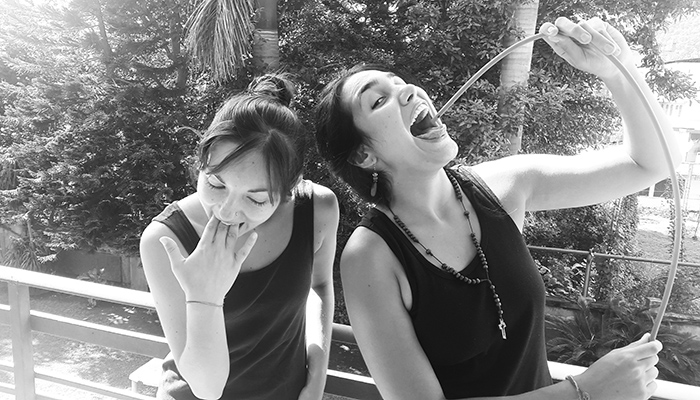*Please don’t attempt any of these exercises without the guidance of a teacher as they could be dangerous*
I remember reading about kriyas (yoga cleansing techniques) during my first trip to India and thinking how crazy some of them sounded…throwing up, swallowing cloth and sticking tubes down the esophagus…
Originally, I thought they were just ancient practices that people don’t do anymore; I never expected to be trying any. However, the other week on my yoga TTC in Rishikesh, I found myself throwing up salt water and swallowing a long rubber tube in an attempt to conquer the mind.
Practising vamen and danda dhauti
The first exercise was called vamen and involved drinking six glasses of warm salty water on an empty stomach, and then throwing the water back up again by rubbing three fingers up and down the tongue. This, surprisingly, wasn’t as bad as it sounds.
The second exercise was called danda dhauti, which I didn’t quite complete to the end as it required so much mental concentration. I performed this one after vamen which involved drinking two more glasses of salty water and then swallowing a long rubber tube (demonstrated by Maria in the photo). The tube was sterilised before hand in case you’re wondering about germs.
The idea is that you throw up the salt water through the tube. I didn’t get this far, but I did manage to get the tube down my esophagus after quite a few failed attempts. It seemed like such an unnatural thing to do, but part of the exercise was about conquering the mind. And when we conquer the mind, we supposedly feel light.
So, I might not have been able to complete the full exercise, but I did feel incredibly light afterwards, which was an added bonus. And according to the Hatha Yoga Pradipika, practising dhauti is supposed to prevent many diseases brought on by phlegm as well as removing “bronchial diseases such as asthma and Pliha (diseases of the glands and spleen and their enlargement)”.
Will I be doing it again? It’s hard to say. We do kriyas every Friday morning (nice way to start the weekend) so I’ll have to see how brave I’m feeling.
The Six Kriyas according to the Hatha Yoga Pradipika
According to the Hatha Yoga pradipika, there are six yoga kriyas. The examples below are featured in the version by Swami Vishnudevananda. The three examples of Dhauti are from one of my yoga philosophy classes, not the book.
1. Dhautih
There are three types of Dhauti. On my course, we’re practise vamen and danda dhauti on Friday mornings.
- Vamen — drinking salt water on an empty stomach and throwing it up.
- Danda dhauti — drinking salt water, and then inserting a long tube into the mouth and swallowing it. You then throw the salt water back up so it comes out of the tube.
- Vastra — swallowing a long wet piece of cloth and slowly drawing it out again.
2. Bastih
I haven’t tried this one. According to the Hatha Yoga Pradipika, this involves getting into water up to the navel, sitting in Utkatasana (chair pose), resting the body on the toes and pressing the heels into the buttocks. A small bamboo tube is then inserted into the anus. The anus is contracted which helps to draw water into the stomach. You’re then supposed to shake and expel it.
3. Netih
I wrote about Nethi in a previous post. These are nasal cleaning exercises which involve inserting a small thread or tube into one nostril and drawing it out of the mouth. You then repeat on the other side. This is known as sutra netih. The other nasal exercise is jala netih which isn’t in the Hatha Yoga Pradipika, but involves pouring lukewarm salt water in one nostril, so it comes out of the other nostril. You can read more about that here:
Trying out nasal cleansing techniques on my yoga TTC in India
4. Trataka
Most people associate this with candle gazing, which is how we’ve been practising it on my TTC, but Trataka basically involves looking (without blinking) at an object with concentration, until tears form. The first time I tried this I couldn’t cry, but on the second attempt, I loved the feeling.
5. Naulih
This involves rotating the stomach right and left with bent shoulders. I still haven’t managed to do this yet.
6. Kapalabhatih
Yes, kapalabhatih is a kriya, not a pranayama exercise! This one involves exhaling forcefully and is often known in yoga as the shining skull exercise as it brings a glow to the practitioner and is supposed to remove any phlegmatic diseases.
Finally, please feel free to share your thoughts if you’ve tried any of the kriyas mentioned.

